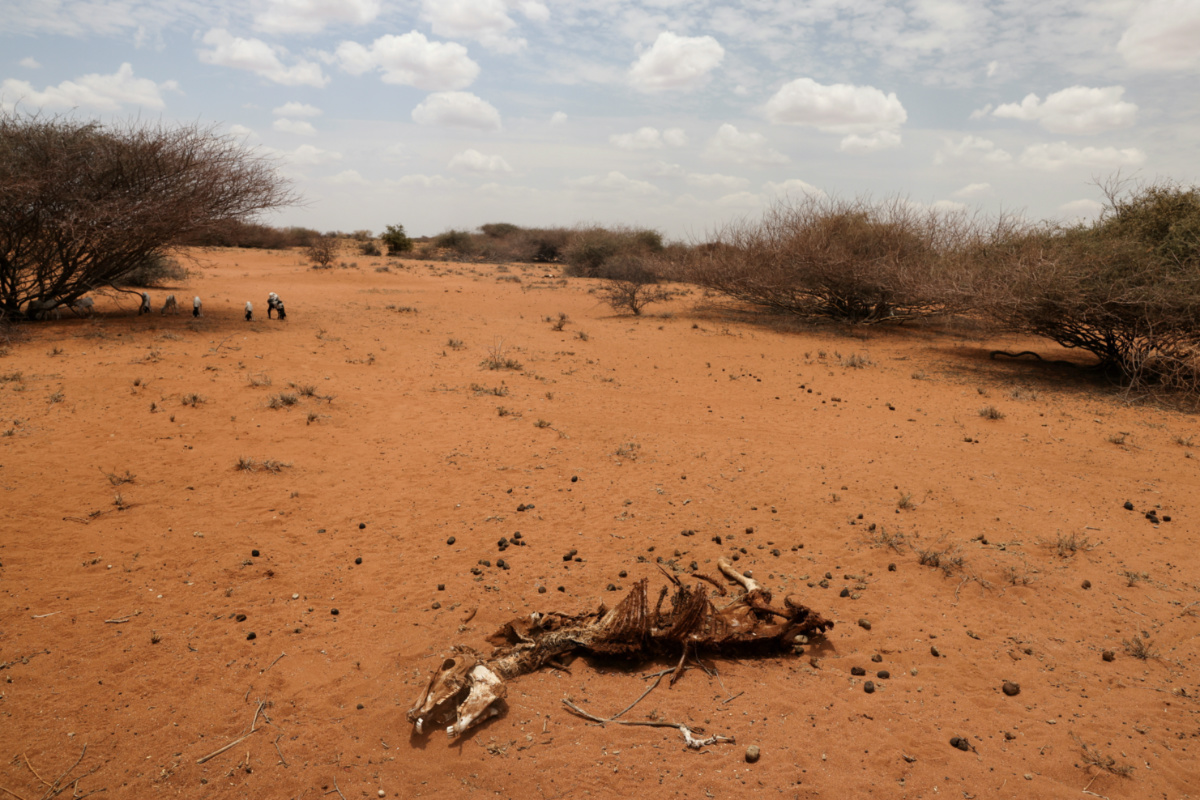Glasgow, UK
Reuters
As climate change triggers deadly heatwaves, droughts and floods, three UN agencies on Wednesday will roll out funding plans to improve weather forecasting in vulnerable countries.
The initiative, announced at the UN climate summit in Glasgow, aims to plug gaps in weather monitoring and data collection so developing countries can better prepare for possible climate-fueled disasters.

The carcass of a donkey who died due to an ongoing drought is seen near the town of Kargi, Marsabit county, Kenya, on 9th October, 2021. PICTURE: Reuters/Baz Ratner.
Over the next decade, organisers at the UN’s World Meteorological Organization plan to boost weather monitoring in 75 small island nations and least-developed countries that have done little to cause the climate crisis but face the biggest and costliest impacts.
“We have to invest in weather and climate services,” WMO Secretary-General Petteri Taalas told conference attendees. “Without observations we are not able to provide good services.”
“In modelling we say that if you put junk in your forecasting models you are getting junk out. Unfortunately that’s the situation in several developing countries and also several island state countries,” he said.
Improving rain forecasts can, for example, help farmers manage their fields, communities manage water resources or governments plan for food imports when yields look likely to falter. They can also allow communities to prepare for possible flooding.
For the Red Cross in Burkina Faso, such forecasts – when they exist – are crucial to the aid organisation’s budget and procurement planning, Red Cross climate scientist Kiswendsida Guigma said.
But in many places, there is a “huge gap” in accuracy and detail, Guigma said. “We don’t have very dense networks of instruments collecting data, and [there is] a lack of human and technical capacity.”
The new initiative, called the Systematic Observations Financing Facility, falls under global plans to provide $US100 billion a year in climate financing to poorer nations.
Failure by rich nations to meet this 2020 goal has earned wide rebuke in Glasgow. On Tuesday US climate envoy John Kerry said the world might meet that goal by 2022.
Improving weather data can also help with longer-term predictability around climate change, said Lars Peter Riishojgaard, director of the WMO’s Earth System Branch.
“If you’re a rural economy with subsistence farming, you need to know: Can people have their livelihoods where they are right now, or do they need to pick different crops?” Riishojgaard said. “If you can’t predict it, you can’t adapt to it.”
We rely on our readers to fund Sight's work - become a financial supporter today!
For more information, head to our Subscriber's page.
Disappearing data
In recent years, weather data for Africa has declined as readings from weather balloons equipped with observation equipment – known as radiosondes – decreased by about half between 2015 and 2020.
Radiosonde data, which unlike satellite data is collected at various atmospheric altitudes, is considered some of the most important information for both weather predictions and climate modeling.
A lack of investment, along with other challenges including security conflicts, has prevented African countries from floating new balloons, said Columbia University climate scientist Tufa Dinku.
“There is almost no data outside the roads, outside the towns and cities,” he said. And “if you think about it, agriculture doesn’t happen in towns or cities.”
That has left African farmers and herders struggling to plan ahead, even as temperatures in the continent’s south rise at one of the fastest rates in the world.
Madagascar, off Africa’s south-east coast, has this year suffered from a crippling famine that scientists say is caused by climate-fueled drought.
More than a million people on the island face extreme hunger in a nation that has produced less than 0.01 per cent of the carbon-dioxide emissions that are causing global warming, according to the Global Carbon Project.
Globally, weather-related natural disasters have increased five-fold over the last 50 years, the WMO said. More than 91 per cent of the associated deaths have occurred in developing countries.
Prime Minister of Fiji Frank Bainimarama told attendees at the initiative’s rollout that climate-driven superstorms, rising seas, and changing weather patterns are the “new norm” in the Pacific. He added that 13 cyclones have struck the island nation since 2016.
“Disaster readiness and disaster resilience are two sides of the same coin,” Bainimarama said. “They both depend on robust weather and climate data.”
– Additional reporting by ALESSANDRA PRENTICE.






